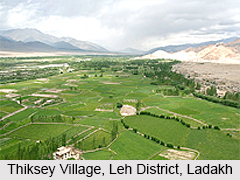 Thiksey is a village located in the Leh district of Ladakh, in the Indian state of Jammu & Kashmir. It comes under the Leh tehsil (sub-division) of the district and is known prominently for the famous Thiksey Monastery that strikingly sits atop a hill in the village, adding to the spectacle of the place.
Thiksey is a village located in the Leh district of Ladakh, in the Indian state of Jammu & Kashmir. It comes under the Leh tehsil (sub-division) of the district and is known prominently for the famous Thiksey Monastery that strikingly sits atop a hill in the village, adding to the spectacle of the place.
Geography of Thiksey, Leh, Ladakh
The village of Thiksey is elevated at an altitude of approximately 3,500 metres (11,500 feet) above mean sea level.
Demographics of Thiksey, Leh, Ladakh
As per the Census India 2011 report, the total population of Thiksey stands at 2,237, of which 1,111 inhabitants constitute males and the remaining 1,126 constitute females. The male-female sex distribution ratio of the village thus comes to 0.99 approximately. The population of the village consists of primarily the Scheduled Tribes.
The population of children between 0 to 6 years of age is 227, being 10.15 per cent of the total population of the village. The Female Sex Ratio (population of females per 1000 males) is around 1,013, against the state average of 889. The Child Sex Ratio (population of girl child per 1000 male children) is 1,045, much higher than the state average of 862.
Literacy in Thiksey, Leh, Ladakh
The literacy rate of Thiksey village is 67.77 per cent, compared to the state average of 67.16 per cent. The effective literacy rate, i.e., the literacy rate of population excluding children aged 6 and below, is 75.42 per cent. The male literacy is around 75.7 per cent (effective literacy 84.1 per cent), while female literacy is about 59.95 per cent (effective literacy 66.83 per cent).
Administration of Thiksey, Leh, Ladakh
The village of Thiksey has an administration over a total of 433 households.
This article is a stub. You can enrich by adding more information to it. Send your Write Up to content@indianetzone.com



















